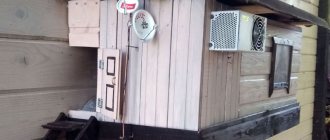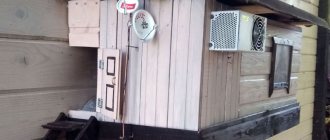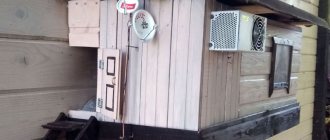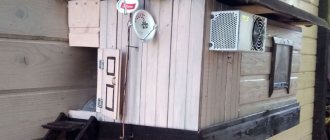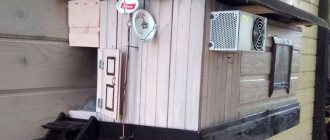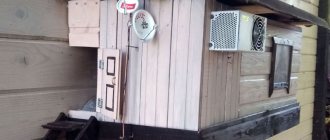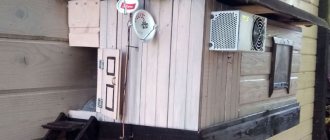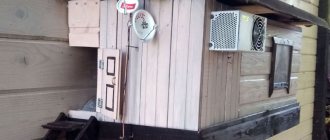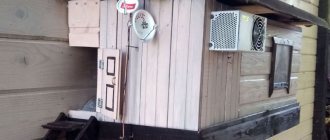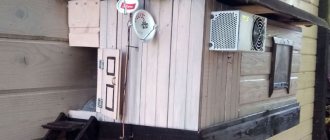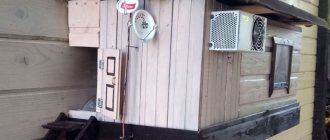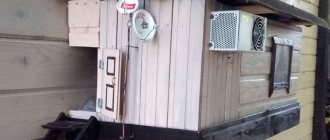Another homemade product for those who are bored at home
I needed a couple of antennas for digital, in places with “not the best reception”... I went shopping (this was before self-isolation - if it’s relatively budget-friendly, then it’s complete G. The more expensive one looks decent, but how it works is questionable.
- if it’s relatively budget-friendly, then it’s complete G. The more expensive one looks decent, but how it works is questionable.
I decided to make something homemade. It was somehow awkward to “twist” an antenna from a piece of cable (although rumor has it it works) - I wanted something simple, but more decent and advanced
In fact, the one I made is not radically more complicated, but somehow more “solid” or something. And the results of its testing were very encouraging, so I decided to sketch out a short description of what and how, in case someone else finds it useful 
... even if my street cats have a “normal” antenna on their house, what can you do without an antenna?!
The wire is not all finished yet, now we’ll assemble something!

In the places described, I previously used home-made broadband log-periodic antennas, probably since the “beginning of perestroika.” They worked well in analog and not only on UHF, but “for some reason, digital was too tough for them.” I didn’t really delve into the essence of the reasons, I removed them and began to think about what to replace them with. Here is one of them, waiting for a place in the trash
They worked well in analog and not only on UHF, but “for some reason, digital was too tough for them.” I didn’t really delve into the essence of the reasons, I removed them and began to think about what to replace them with. Here is one of them, waiting for a place in the trash
A little history
In the early 60s of the last century, our compatriot Kharchenko K.P. developed a simple flat zigzag antenna with good characteristics.
Copyright certificate No. 138277 for an invention called “Band directional antenna” was issued to Konstantin Pavlovich Kharchenko in 1961 (according to his application dated June 16, 1960). In the same year, materials were published in the magazine “Radio” for repetition by radio amateurs.
The antenna is not critical to materials and dimensions during manufacturing, has a simple good match with the reduction cable, and it successfully combines multiple elements of a common-mode antenna array with a single feed point.
Technical details
What attracts a potential buyer most of all is the huge number of available channels - more than 100. In fact, this is an outright deception that emphasizes the technical illiteracy of the manufacturers of the Aerial 2100 antenna. However, this does not relieve the buyer of responsibility; you need to understand what exactly you are paying money for.
There is also some truth in the legend created by the manufacturers. The fact is that partly digital television can really be called free. On the territory of the Russian Federation, the free package includes only 20 TV channels, there is no talk of any 100.
There are exceptions. For example, in Moscow you can tune in about 30 TV channels. However, remember that this is the maximum, that is, you absolutely cannot watch 100 channels for free.
If you contact the manufacturer with additional questions, for example, how the antenna allows you to connect more than 100 channels, then they will tell you absolute nonsense. The most common legend is that the signal is received from cell towers.
The second technical subtlety is the design of the Aerial 2100. This is an ordinary indoor antenna. The UHF antenna (decimeter range) is capable of receiving a digital signal qualitatively; in our case, we have a meter range. That is, it can function correctly solely as an element of collective reception.
The third caveat is that not every receiver is capable of receiving a digital signal. Do not believe that this antenna is ideal for plasma TVs.
To receive a digital signal, you need a receiver with a DVB-T2 tuner. Naturally, when plasmas were created, they were not equipped with such receivers, since this standard did not exist. Built-in tuners are found only in modern TV models.
To connect plasma to digital television, you need to use a special set-top box, which can be purchased separately. Naturally, antenna sellers will absolutely not tell you about this.
Theory and calculations
The described antenna, in theory, has a horizontal “figure-of-eight” radiation pattern and a relatively high gain, which can be further increased by using a reflector/reflector.
To obtain maximum gain on all channels, it is necessary to make an antenna approximately in the middle of the range between the multiplexes used.
Finding (for calculations) the frequencies of multiplexes used in your region is easy,
for example, a request like “dvb-t2 channel frequencies” + “Krasnodar”
I found something like this:
The middle, between “my” two multiplexes, is 700 MHz - we will calculate the antenna at this frequency.
As a basis for calculating the dimensions of the antenna, we take the drawing of its author
Calculate the wavelength: λ = 300 / f [m]
300/700 = 0.428m, approximately 43cm length of each side of the rhombus
λ/4
=43/4= 10.75
The total length of the material we need (11cm*8=88cm) is less than a meter. The distance between the reduction contacts, where we will solder the cable, is 10-12mm (the standard value for this antenna for frequencies below 900 MHz).
I will make a simple antenna, without a reflector, however, to further increase the gain of this antenna, it is quite possible to install it behind it
for example, from a metal mesh/grill, foil material or simply a metal plate. Its dimensions should be approximately 20 percent larger than the dimensions of the antenna and it should be located at a distance of ƛmax/7. For my case: wavelength (channel 39) 300/618, it turns out...49/7= that is, about 7cm
For those who are too lazy to do the calculations themselves
— you can use an online calculator, the results will differ only slightly from those I received. Here, for example, this one - here you immediately enter the frequencies of two multiplexes and get the dimensions of the antenna (without a reflector) Or another option, with a reflector - I really want to note that in the second option a slightly different calculation option is used, different from the author’s. An antenna with angles other than 90° is assumed and the reflector distance is calculated as λ/8
To make the antenna sheet, it is recommended to use aluminum or copper (copper is easily soldered) with a diameter of 3 mm and higher - the larger the diameter, the more broadband the antenna is. You can use tubes; the thickness of the walls is not important, since only the surface of the material is used (in fact, you can wrap any dielectric with foil to obtain the required material). However, in my opinion, the easiest way is to buy a meter of large-gauge copper wire at an electrical supply store.
What antenna is needed for digital TV
Do you need an antenna for digital television? Yes. Now regarding the question of what is the best antenna to buy for digital TV. You can use ordinary terrestrial devices that operate in the UHF range. Often, users do not want to purchase another antenna, because they can use an existing model and a purchased digital set-top box.
But most often, the old antenna and digital set-top box are not able to provide the user with a high-quality signal in the required range. There is one most common misconception regarding the fact that the set-top box converts an analog signal into a digital one. That is, quality is being improved.
In reality, everything happens completely differently. The digital stream is most often broadcast in parallel with the analogue one, and in most cases on other frequencies. It turns out that if the user has poor viewing of meter range channels, then receiving the UHF range may encounter difficulties. It is on this band that digital TV is broadcast.
One of the myths is that the set-top box does not need an antenna to function. It is important to choose an antenna for digital television; without it, the receiver will not cope with its tasks. Another situation is when, in the range of reliable signal reception, it is enough to install a piece of wire at the antenna input. This approach can provide results in isolated situations.
Remember two points: an outdoor antenna will always receive better than an indoor antenna, even when the indoor antenna is equipped with the most powerful amplifiers.
If you decide to purchase this device, you still need to dwell on the question of how to choose an antenna for digital television. There are a number of requirements that will ensure improved signal quality on TV. Key factors that are especially important for channel reception:
- Work must be carried out on the UHF range. Remember that devices that receive signals exclusively on the meter band are not intended for DVB-T2.
- It is recommended to purchase a model with an amplifier. When it comes to a city where the TV tower is located nearby, a signal booster is not required. For residents of settlements remote from the zone of reliable reception, an amplifier is considered an indispensable element for obtaining a high-quality signal.
- The device must be pointed in the right direction towards the TV tower. This will avoid signal distortion.
- When a noisy signal arrives, then you can try an antenna with filters at the output. You can purchase an additional filter for additional protection against LTE signals separately. Here it is important to look at what channels the TV will skip so as not to miss the opportunity to watch your favorite program. This interference comes from mobile phone towers, and the filter allows you to cut it off.
- Consider the amount of TV. To connect 1 TV, the choice often falls on a passive type of device. When there are several TVs in a house or apartment, then it is better to choose active models.
Next, we will consider the main types of antennas, their features and conditions for use.
Indoor or outdoor
When choosing an antenna, you need to take into account not only the distance from the tower, but also its power rating.
A 100-watt transmitter will provide excellent signal reception somewhere at a distance of 10 km, kilowatt - 35 km, 5W up to 50 km. At the same time, only a few residents can get direct visibility of the television tower in the city, and the distance at which the signal can be received without an amplifier is reduced. To select a device wisely, you should analyze all types of equipment available on the modern market.
An antenna for digital TV is:
- room;
- external
Let's take a closer look at the two groups.
Rooms that do not have an amplifier are considered a good option for an area with a strong signal. Please note that these are the simplest models, the price is around 500 rubles no more.
When the signal from the tower is not strong, and there is no desire or no opportunity to hang the antenna on the roof, then an indoor antenna with an amplifier is an alternative.
An outdoor antenna for digital TV or a street one is considered the optimal solution for those whose home is located far from a TV tower, and there are also obstacles to receiving a high-quality signal.
The advantage of outdoor models is that they come in different sizes; installation is allowed anywhere in order to obtain a clearer and more powerful signal. Such a device will provide any user with reliable reception, but there are a number of nuances regarding the installation features and finding a place for installation.
For areas of strong and medium signal, it is allowed to use outdoor models without an amplifier. When we are talking about a long distance or not the most favorable conditions for catching reception, such as difficult terrain or tall buildings, then it is better to choose a model with amplification, and even set the antenna to the tower.
To install the antenna in the desired direction, look at how your neighbors do it and see if they have good reception. The second option is to rotate the TV antenna yourself and evaluate for yourself in which position the TV shows better. Please note that you need to switch channels to see if everyone has a good picture and sound without interference.
Regarding the installation height, it is recommended to adhere to the principle “the higher, the better.” For city residents 25-30 m, in the suburbs and small towns 20 m, for rural areas at least 10 m. Regarding the choice of installation location, the roof or gable of the building is best.
Please note that there are universal TV antennas that can be installed both inside and outside the house. According to the manufacturers, such models are capable of providing good signal reception at a distance of no more than 25 km from the tower; moreover, they immediately come with filters against frequency interference of the mobile network.
Active or passive
Antennas for receiving digital television are divided into two types:
- passive;
- active.
Now let's look at each of these antennas for DVB digital TV. Knowing the features of each type, the user will be able to choose the most optimal model depending on the conditions.
Passive antennas for digital TV are a common design, represented only by the receiver. The task of such a device is to receive incoming signals. This group is characterized by a gain of up to 9 dB. This type of TV antenna is considered the most affordable and is most often found in cities.
Active antennas for digital television DVB T2− are a design that contains an amplifier, so the price for such a product is higher. Please note that an antenna with an amplifier for digital TV requires additional power consumption. At the same time, you get a clearer signal at a greater distance from the TV tower and in the presence of other factors that negatively affect the quality of the signal.
An active antenna with an amplifier for digital TV is suitable for those whose home is located far from the tower or there are other factors affecting the quality of signal reception.
TV signal parameters
Level is an indicator of how strong the signal is at the input to the tuner. Please note that this level is not determined by the user or the seller of the UHF digital television antenna. Each digital tuner's menu contains a function that shows the strength of your signal level.
Quality is a key indicator; it is for this reason that every lover of series, news and television shows tries to purchase a reliable antenna for DVB T2 digital television. This parameter shows how suitable the TV signal is for digital decoding without interference. The tuner independently calculates the quality and whether it can show it to the viewer through the menu.
If the frequency of the required multiplex is set, the user will see graphic displays on the TV screen, the levels and quality of the reception itself. Then, by rotating the digital television antenna in different directions and placing it in different places, it will be possible to evaluate how these parameters change.
Please note that it is especially difficult to place an antenna on the territory of a country house or in a country house. A minimum movement of one meter in any direction is enough and the reception changes significantly.
Location and installation
The quality of TV reception will vary depending on the location of the digital TV antenna. All these subtleties must be taken into account when choosing equipment. The main factors influencing the choice of television antenna and its layout:
- transmitter power;
- coverage area;
- terrain;
- the presence of potential barriers to the signal: trees, towers, all kinds of buildings;
- multi-storey buildings;
- the ability to direct the TV antenna towards the repeater.
Based on these criteria, it is determined which antenna is needed to receive digital TV. The antenna can be placed indoors or outdoors. It all depends on the signal level. Dense development of the territory, location on the edge of the coverage area - these factors do not allow the use of an indoor TV antenna. However, the external model of the transmitter will provide high-quality reception even under such conditions.
The kit for outdoor antennas includes all kinds of fasteners required for installation. You can do the installation yourself or entrust this difficult job to specialists.
An external antenna should be installed if problems arise with digital signal reception. In all other situations, you can rely on an indoor antenna.
Housing complexes built relatively recently are equipped with a complex collective television antenna. Devices of this type are equipped with several powerful receivers, from which all types of television broadcasting that are popular today are connected via a common cable.
During installation, you need to take into account several important nuances. The height of the transmitter in relatively sparsely populated areas should be more than 1.2 m. Provide independent power for the amplifier and antenna. Instructions for connecting a television antenna:
- The plug connects to the tuner or directly to the TV.
- The amplifier is connected to a general network or TV.
- Independent power supply for the transmitter and amplifier is configured.
- Tuner system connection.
- You can enjoy watching.
To install the antenna, you will need special equipment.
Antenna assembly
Let's remove the insulation from a piece of wire one meter long.
I got a wire with a diameter of 4.5mm
The tools you will need are a vice and a hammer. Measure approximately 11cm each and bend at an angle of 90°
The end result is to get such a “geometric” figure 
We cut off the excess and solder the ends. It should look something like this...
Solder the cable as shown in the photo.
We lay the cable along one side of the square and secure it with clamps. This arrangement of the cable is necessary for its coordination (there are different opinions, not everyone agrees with this statement).
When using a reflector, the antenna sheet at the extreme points of the squares can also be secured using metal stands, for example, soldered onto the remains of the same copper wire - there are points with zero potential (highlighted in green). In other places, fastening is allowed only through a dielectric.
The essence of the proposal
The manufacturer markets its product as a “miracle antenna”, because users will be able to set up a clear image, regardless of the connected TV. As a result, over 100 channels will be available for viewing.
The absence of a subscription fee and the need to purchase additional equipment is a kind of cherry on the cake. Receivers, satellite dishes – you don’t need all this. Just order this antenna and enjoy high-quality television broadcasting with an abundant number of available channels.
The manufacturer doesn't stop there. After all, in order to force a potential buyer to act, additional motives will be required. The best argument for purchasing the Aerial 2100 is turning off terrestrial television. Therefore, the decision must be made here and now, without postponing it.
As a result, the buyer gets the feeling that the antenna in question is the only available way to watch TV channels at the lowest price. It’s not surprising, because buying and connecting 1 antenna is much easier than setting up satellite TV broadcasting.
There is some truth in all this, the process of eliminating terrestrial television has already begun, and the transition to a digital format is actively underway. However, if initially the government of the Russian Federation planned to implement this plan during 2021, today more and more often other dates are mentioned - 2021.
However, even if all regions of Russia are disconnected from terrestrial TV, this does not mean that your TV will be transformed into a pile of useless chips. You shouldn’t fall for such offers; there are truly proven solutions - cable, satellite, Internet TV. After all, modern TVs are equipped with a built-in T2 receiver; you just need to connect a cable to it.
Tests
And finally, a performance check and a rough
assessment of the quality of the resulting antenna.
In fact, everything is simple with the test - turn it on, it works! And to evaluate whether the game was “worth the candle,” let’s compare the parameters of the received signal from the manufactured antenna with the one I’m already using at the dacha, with a declared gain of 11dBi
And to evaluate whether the game was “worth the candle,” let’s compare the parameters of the received signal from the manufactured antenna with the one I’m already using at the dacha, with a declared gain of 11dBi
The antenna is installed in the attic of a country house, at a distance of approximately 16 km from the tower.
Signal level: factory stationary antenna on the left / homemade on the right
At first glance, the difference is only 1% (95 versus 94) - but this is not a completely correct comparison, since my external antenna is connected through a splitter, which further weakens the signal.
Active and passive antennas
An antenna with external power from an outlet or receiver (active antenna) has increased sensitivity, and at the same time is almost the same in price as its passive counterparts. A passive antenna must be taken with a reserve. Active models of outdoor antennas have only one drawback - after the winter period, condensation may accumulate on the amplifier. And if the moisture is not removed, the amplifier may burn out. To summarize the above, for the city, take an indoor active antenna. For a summer residence, it is better to buy an outdoor TV antenna, also active.
Choose a digital antenna individually for yourself.
Assessing the performance of the antenna
Let's try to make a more correct comparison by connecting through the splitter input.
Well, in addition, for clarity, let’s add the number of participants List of antennas taking part in the comparison:
1. External antenna Funke BM 4551 external long-range,
declared gain, from some sources (bought at Yulmart), up to 16dB
2. There is an old UHF loop antenna, from TV Electronica 313d, I must say, despite its simplicity, it’s a very good antenna, that’s why it’s been preserved 
3. I went to the store and bought for comparison in the review one of the cheapest, such as a symmetrical vibrator (100% the most purchased by pensioners, due to the low price).
I will carry out all “measurements” at one point, located as close as possible to the external antenna - its location was experimentally selected based on the maximum signal, so we can say that the conditions are approximately the same
So, we have already seen the signal level from the external antenna at 95% (at the time of current measurements it showed 94%), we take it as a standard. All comparisons are made by connecting antennas to the input on the splitter, to which an external antenna is usually connected.
Loop antenna, from Electronics 82% on 39 multiplex and 66% on 60
Budget with “horns” - 62%/38% (on the verge of losing the broadcast)
- 62%/38% (on the verge of losing the broadcast)
Double square - 92% on both multiplexes, about a couple of percent less than the external one
Out of curiosity, I decided to check the work of the reflector, which is easy to make from any metal mesh, plate or even foil... It REALLY works noticeably! The level rose to 96%!, which is even higher than the stationary one, with a declared gain of 11dB.
The most interesting thing is the object that I used as a reflector! 
There was no foil in the house; the only thing available with a metal surface of the required size was... a laptop cover (I have a metal case). But the main thing is the result! It’s clear that I’m not going to “tie” the laptop to the antenna, and its amplification is enough for me without a reflector
Real possibilities of Aerial 2100
If the consumer is already hooked, has read the offer on the manufacturer’s website or in a TV store, then with a high degree of probability he will pay money for this antenna. Why not? Buyers are offered a truly relevant solution to pressing problems for reasonable money.
In fact, you shouldn’t believe advertising so sincerely. First you need to study in detail the specifics of the issue. Otherwise, the money will simply be thrown away.
Initially, you are offered to purchase an antenna for only 98 rubles, why not buy it? However, during the ordering process the situation becomes clear, this is only a bonus price for the second antenna. Already here you should be overcome by doubts, why do I need two antennas?
Let’s assume you didn’t notice this trick or deliberately ignored it. It is possible that you have decided to sell the second antenna to your acquaintances, friends, or through a free bulletin board. In the end, it is possible that you have 2-3 TVs in your house, so there will definitely be work for a second antenna. All this is actually not particularly important, because the essence of deception is completely different.
When placing an order, you will be notified through the operator that two antennas have been sent, the package includes plugs and remote controls. In addition, the manager will assure the buyer that the Aerial 2100 has the most powerful signal both in the city center and on the outskirts. As a result, you will pay about 2000-3000 rubles, depending on the cost of shipping the equipment.
It is possible that you will not find any of the promised remote controls in the kit. They will simply send you the most ordinary indoor antennas, the so-called “slingshots”.
Conclusion:
I can confidently recommend repeating it!
Simple, “cheap and tasty”... One of the simplest, indoor antenna mounts... with ordinary suction cups - if you’re lucky with the direction to the television center
The next antenna "recommended for repetition" is... log periodic
“Crazy hands” were with you. Good luck and good mood to everyone! ☕
Good luck and good mood to everyone! ☕
